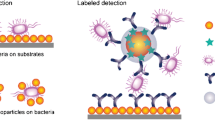Abstract
As an effective analytical method, surface-enhanced Raman spectroscopy (SERS) is widely used in the detection of nucleic acids, amino acids, and other biomolecules. However, obtaining the SERS signal of nonaromatic amino acids is still a challenge. In this work, excess sodium borohydride was used as a reducing agent to prevent the surface of silver nanoparticles from being coated with AgO to enable amino acid molecules to reach the surface of silver nano-substrates. Calcium ions were used as aggregators for silver nano-substrates to successfully achieve the label-free and accurate fingerprint determination of various nonaromatic amino acids. Different types of amino acids were distinguished based on the changes in their peak intensity that were obtained using colorless and transparent organic dichloromethane (DCM) as the internal standard. A Raman signal for low-concentration amino acids in body fluids was detected, and the detection limit for tyrosine was 5 ng/mL. Moreover, the physical and chemical properties of peptides and the formation of peptide chains were further analyzed. The proposed method can potentially be applied to protein sequencing.
Graphical abstract






Similar content being viewed by others
References
Simonson M, Boirie Y, Guillet C (2020) Protein, amino acids and obesity treatment. Rev. Endocr. Metab. Disord 21(3):341–353
Spergel DJ (2019) Modulation of gonadotropin-releasing hormone neuron activity and secretion in mice by non-peptide neurotransmitters, gasotransmitters, and gliotransmitters. Front. Endocrinol 10:329
Lieu E L, Nguyen T, Rhyne S, Kim J (2020) Amino acids in cancer. Exp. Mol. Med 52(1): 15-30
Liu D, Zhou P, Nicolai T (2020) Effect of kappa carrageenan on acid-induced gelation of whey protein aggregates. Part II: microstructure. Food Hydrocoll 102:105590
Chinta JP (2017) Coinage metal nanoparticles based colorimetric assays for natural amino acids: a review of recent developments. Sens. Actuators B Chem 248:733–752
Kumar H, Singh G, Kataria R, Sharma S K (2020) Volumetric, acoustic and infrared spectroscopic study of amino acids in aqueous solutions of pyrrolidinium based ionic liquid, 1–butyl–1–methyl pyrrolidinium bromide. J. Mol. Liq 303: 112592
Nakanishi M, Tsuboi M (1978) Measurement of hydrogen exchange at the tyrosine residues in ribonuclease A by stopped-flow and ultraviolet spectroscopy. J. Am. Chem. Soc 100(4):1273–1275
Dunker A, Williams R, Peticolas W (1979) Ultraviolet and laser Raman investigation of the buried tyrosines in fd phage. J. Biol. Chem 254(14):6444–6448
Stevens E, Morris E, Charlton J, Rees D (1987) Vacuum ultraviolet circular dichroism of fibronectin dominant tyrosine effects. J. Mol. Biol 197(4):743–745
Zhu Y Y, Wu X D, Abed M, Gu S X, Pu L (2019) Biphasic enantioselective fluorescent recognition of amino acids by a fluorophilic probe. Chem. Eur. J 25(33): 7866-73
Violi J P, Bishop D P, Padula M P, Steele J R, Rodgers K J (2020) Considerations for amino acid analysis by liquid chromatography-tandem mass spectrometry: a tutorial review. TrAC-Trend. Anal. Chem: 116018
Sharma B, Frontiera R R, Henry A-I, Ringe E, Van Duyne R P (2012) SERS: Materials, applications, and the future. Mater. Today 15(1-2): 16-25
Luo Y, Wen G, Ma L, Liang A, Jiang Z (2017) A sensitive SERS quantitative analysis method for amino acids using Ruhemann’s purple as molecular probe in triangle nanosilver sol substrate. Plasmonics 12(2):299–308
Madzharova F, Heiner Z, Kneipp J (2017) Surface enhanced hyper-Raman scattering of the amino acids tryptophan, histidine, phenylalanine, and tyrosine. J. Phys. Chem. C 121(2):1235–1242
Ranc V, Chaloupková Z (2020) Perspectives of DCDR-GERS in the analysis of amino acids. Analyst 145(23):7701–7708
Huang J A, Mousavi M Z, Giovannini G, Zhao Y, Hubarevich A, Soler M A, et al. (2020) Multiplexed discrimination of single amino acid residues in polypeptides in a single SERS hot spot. Angew. Chem. Int. Ed 59(28): 11423-31
Xu L-J, Zong C, Zheng X-S, Hu P, Feng J-M, Ren B (2014) Label-free detection of native proteins by surface-enhanced Raman spectroscopy using iodide-modified nanoparticles. Anal. Chem 86(4):2238–2245
Wang X, Zeng J, Sun Q, Yang J, Xiao Y, Zhu Z et al (2021) An effective method towards label-free detection of antibiotics by surface-enhanced Raman spectroscopy in human serum. Sens. Actuators B Chem 343:130084
Wen C I, Yu C N, Thirumalaivasan N, Hiramatsu H (2021) 532-nm-excited hyper-Raman spectroscopy of amino acids. J. Raman Spectrosc 52(3): 641-54
Woody RW (2009) Circular dichroism spectrum of peptides in the poly (Pro) II conformation. J. Am. Chem. Soc 131(23):8234–8245
Lopes JL, Miles AJ, Whitmore L, Wallace BA (2014) Distinct circular dichroism spectroscopic signatures of polyproline II and unordered secondary structures: applications in secondary structure analyses. Protein Sci 23(12):1765–1772
Funding
This work was financially supported by the HMU Marshal Initiative Funding (No: HMUMIF-21012).
Author information
Authors and Affiliations
Corresponding author
Ethics declarations
Conflict of interest
The authors declare no competing interests.
Additional information
Publisher’s note
Springer Nature remains neutral with regard to jurisdictional claims in published maps and institutional affiliations.
Supplementary Information
ESM 1
(DOCX 13158 kb)
Rights and permissions
About this article
Cite this article
Wang, X., Liu, X., Wang, X. et al. A versatile technique based on surface-enhanced Raman spectroscopy for label-free detection of amino acids and peptide formation in body fluids. Microchim Acta 189, 82 (2022). https://doi.org/10.1007/s00604-022-05191-y
Received:
Accepted:
Published:
DOI: https://doi.org/10.1007/s00604-022-05191-y




